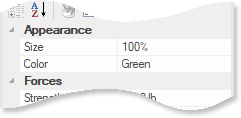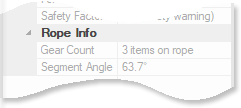
This also applies to cable, chain, and webbing.
Gear that is anchored includes anchors, rocks, trees, tripods, trucks, etc.
A "bight" is a simple loop in a rope that does not cross itself.
A "bend" is a knot that joins two ropes together. Bends can only be attached to the end of a rope.
A "hitch" is a type of knot that must be tied around another object.
"Descending devices" (e.g., ATCs, Brake Bar Racks, Figure 8s, Rescue 8s, etc) create friction as their primary purpose. The friction in descending devices is always considered when calculating forces.
The "Safety Factor" is the ratio between the gear's breaking strength and the maximum load applied to the gear (e.g., 5:1).
The Appearance section in the properties pane allows you to modify a rope's size and color. The Forces section allows you to change the rope's strength.

The Size field controls the diameter of the selected rope. You may want to reduce the size of a rope to create the appearance of a cable. Learn how to specify the size of rope, webbing, and hoses in mm, cm, and inches.
The Color field is available only when webbing or a round rope is selected. Knots (except Münters and bends) inherit the color of the rope or webbing to which they are connected (münters are always green and bends inherit the color of one of the ropes).
The Rope Info section in the properties pane displays the number of items that are connected to the rope and the last rope segment that was selected (i.e., clicked with your mouse).

Watch a video about the properties pane
Watch a video that explains how to work with rope and webbing.